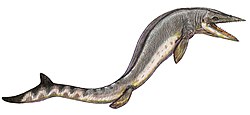The topic of this article may not meet Wikipedia's notability guideline for stand-alone lists .(May 2025) |
Although the evidence is rare, fossils reveal that there were Mesozoic reptiles, including dinosaurs in New Zealand. Possibly because it lacks the right conditions for fossilization, only fragmentary dinosaur remains have been found there. These fossils are often only a single bone or a piece of a bone, and thus the dinosaurs' species cannot be identified. By comparing the fossils with other, more complete remains from other areas it can be inferenced which family or order a given fossil belonged to. Marine fossils are more common than fossils of land animals in New Zealand because dead animals and plants are easily preserved in sand and mud. Therefore, some fossils of marine reptiles are complete enough to be assigned to a specific genus or species.



